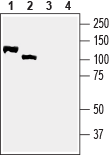Overview
- Peptide (C)RDIRIKYGNGRKNSR, corresponding to amino acid residues 297-311 of rat Neuregulin-2 (Accession O35569). Extracellular, N-terminus.

 Western blot analysis of rat brain membranes (lanes 1 and 3) and mouse brain lysate (lanes 2 and 4):1,2. Anti-NRG2 (extracellular) Antibody (#ANR-114), (1:200).
Western blot analysis of rat brain membranes (lanes 1 and 3) and mouse brain lysate (lanes 2 and 4):1,2. Anti-NRG2 (extracellular) Antibody (#ANR-114), (1:200).
3,4. Anti-NRG2 (extracellular) Antibody, preincubated with NRG2 (extracellular) Blocking Peptide (#BLP-NR114).
 Expression of Neuregulin-2 in mouse hippocampus and cerebellumImmunohistochemical staining of perfusion-fixed frozen mouse brain sections with Anti-NRG2 (extracellular) Antibody (#ANR-114), (1:300), followed by goat anti-rabbit-AlexaFluor-488. A. NRG2 staining in CA1 hippocampal region (green) is detected in the pyramidal layer (P, arrows). B. Staining in the cerebellum (green) is observed in Purkinje cells (arrows). Mol= Molecular layer; GL= Granular layer. Cell nuclei are stained with DAPI (blue).
Expression of Neuregulin-2 in mouse hippocampus and cerebellumImmunohistochemical staining of perfusion-fixed frozen mouse brain sections with Anti-NRG2 (extracellular) Antibody (#ANR-114), (1:300), followed by goat anti-rabbit-AlexaFluor-488. A. NRG2 staining in CA1 hippocampal region (green) is detected in the pyramidal layer (P, arrows). B. Staining in the cerebellum (green) is observed in Purkinje cells (arrows). Mol= Molecular layer; GL= Granular layer. Cell nuclei are stained with DAPI (blue).
- Avramopoulos, D. (2018) Am. J. Med. Genet. B Neuropsychiatr. Genet. 177, 257.
- Centa, A. et al. (2018) Mol. Oncol. 12, 1061.
- Yan, L. et al. (2018) Mol. Psychiatry 23, 1233.
Neuregulins (NRGs) are a multi member protein family involved in cell to cell communication. This family includes four human neuregulin paralogs NRG1-NRG4 which produce multiple isoforms through alternative splicing.
NRGs are involved in several physiological processes including heart and peripheral nervous system development. They act in part by binding to the extracellular region of ErbB/HER transmembrane tyrosine kinases, leading to receptor dimerization and ultimately to the activation of a complex network of downstream signaling events1,2.
NRG2 transcript levels markedly increase following birth, suggesting that NRG2 has important functions in the postnatal and adult brain. Several studies have also shown that NRG2 modulates glutamatergic transmission in GABAergic neurons and selectively affects GluN2B-containing NMDA receptors2,3.
The region containing the NRG2 locus is associated with schizophrenia and other psychiatric disorders and genetically linked to ADHD in genome-wide scans2.
Application key:
Species reactivity key:
Anti-NRG2 (extracellular) Antibody (#ANR-114) is a highly specific antibody directed against an epitope of the rat protein. The antibody can be used in western blot and immunohistochemistry applications. It has been designed to recognize Neuregulin-2 from rat, mouse, and human samples.
